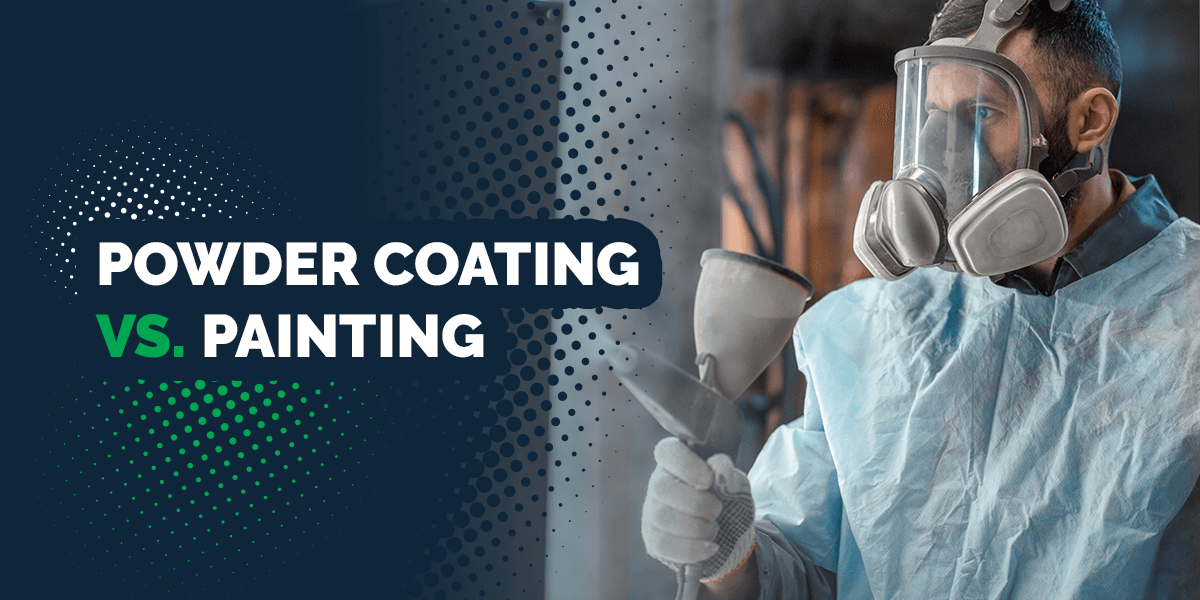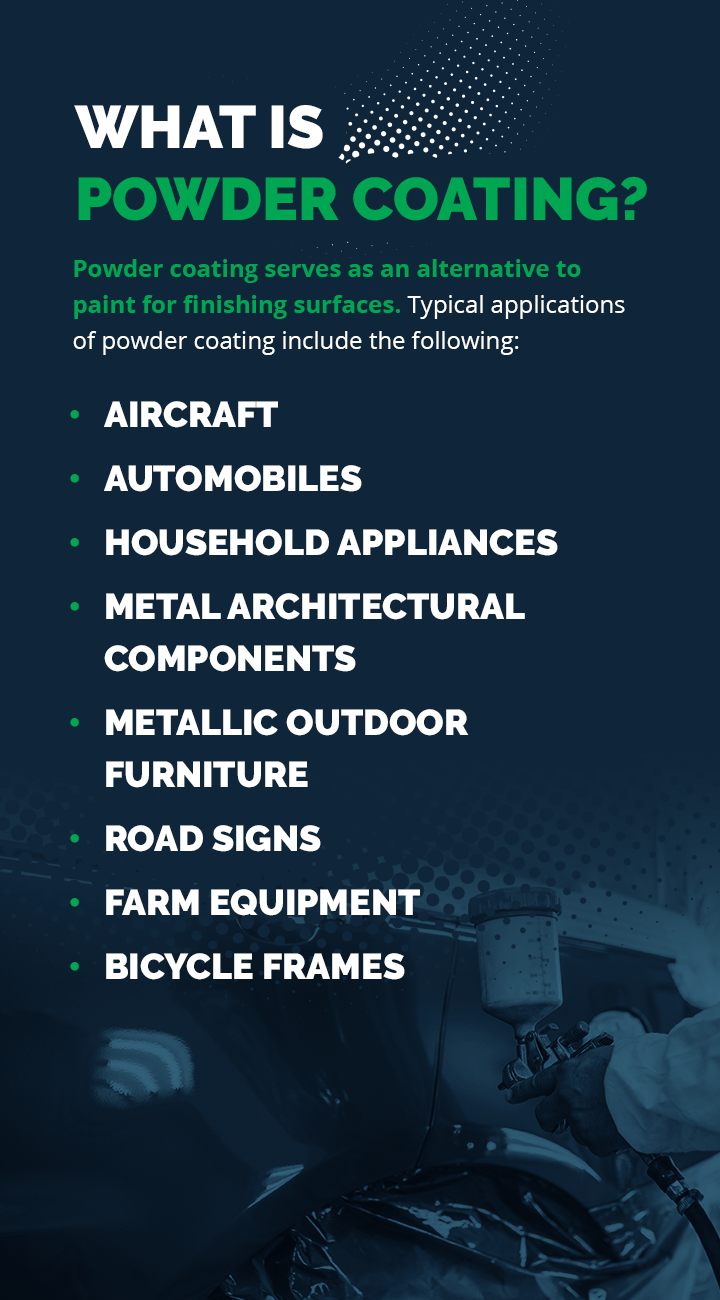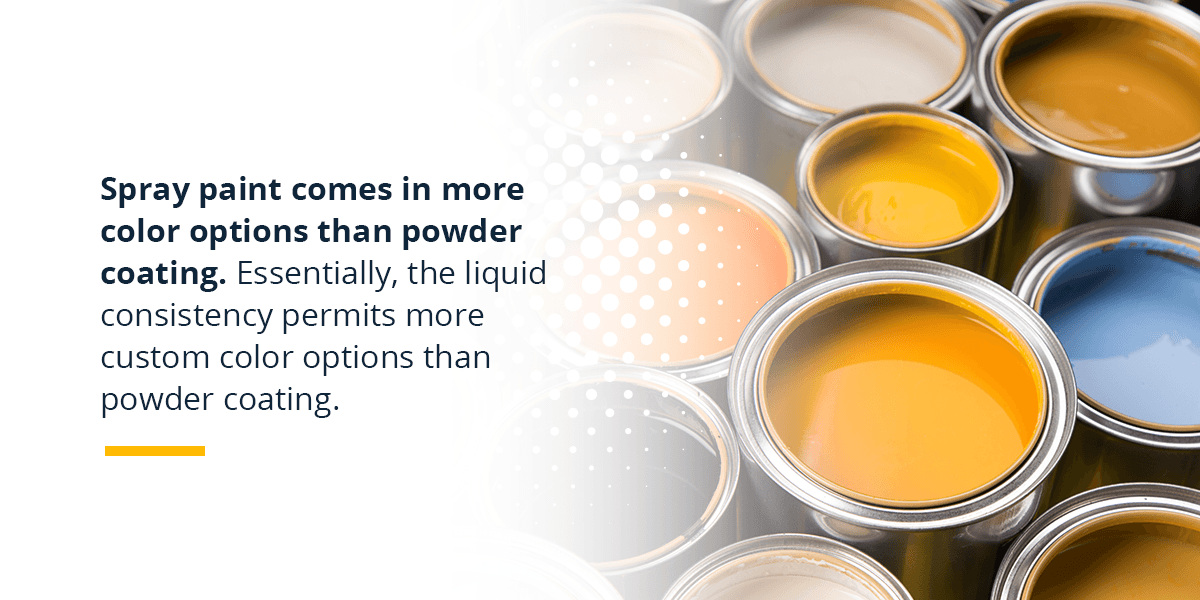
Adding color to aircraft and automobiles requires using long-lasting shades that can withstand continued performance. The two primary options are powder coating and paint. However, because each has its own advantages and disadvantages for specific situations, the two choices aren't always clear. Understanding the difference between powder coating and painting and recognizing which will best benefit your project starts with education.
Powder coating serves as an alternative to paint for finishing surfaces. Rather than starting with a liquid, as spray painting does, powder coating applies a colored powder to the surface. This powder typically contains coloring, additives and resins.
Applicators spray the powder over a surface and cure and set the finish under heat. High temperatures melt the powder, which spreads out to thoroughly and evenly cover the surface with a thick, durable finish that lasts for years, even when used in harsh outdoor conditions.

Powder coating services include one of two main methods of applying the coloring, thermoset and thermoplastic. Thermosets use only heat for setting the color. On the other hand, thermoplastics enhance the setting with the addition of chemicals to the powder coating. Both techniques create the same results — a long-lasting coating that evenly covers and protects the surface.
Typical applications of powder coating include the following:
Typically, most powder coating applications are for steel or other metals. However, because numerous objects are made with metallic materials, powder coating has hundreds of potential applications. Specifically, it's a popular option for large-scale production or coloring sizeable objects. In addition, its many advantages make it useful for various industries, such as military, aviation, automotive, and consumer goods.

There are several powder coating benefits to consider, including the following:
First, because the final appearance makes a significant difference in the choice of finish, the completed look is a top benefit of powder coating. After finishing, surfaces have a thick, uniform coating of color. It doesn't have splotches or drips because the powder smoothly covers the surface without a liquid carrier that can cause areas of unevenness. The appearance also makes a difference because the finish will last for years.
Second, the durability of powder coating is another benefit of this option. It protects objects from scratches, corrosion, heat damage and wear. Therefore, it's ideal for items designed for years of heavy use in harsh environments, such as vehicles, outdoor structures, road signs and aircraft.
Third, powder coating comes in a wide variety of colors, which can match most applications. While it doesn't have as many color options as paint, it comes in a range of shades that work for various purposes.
Fourth, the powder doesn't include volatile compounds. Therefore, it provides a more environmentally friendly product that's safer to work around. Plus, there's much less waste produced from powder coating because the process allows for the reuse of the powder that the applicator doesn't need to finish the project. Therefore, powder coating creates less waste compared to spray painting.
Lastly, even with curing, the powder coating process is faster than painting. Typically, applications require a single coat of powder coating rather than up to three coats of paint. Of course, both processes still require careful surface preparation to ensure proper adhesion of the finish.
While boasting several advantages, powder coating isn't perfect for all applications.
First, it's a high-tech process that requires expensive equipment, such as sprayers and curing ovens. Therefore, providers typically reserve this process for large-scale production.
The second downside to powder coating stems from its process. Because companies that offer this finish must invest in high-quality equipment, powder coating comes at a higher price than paint. The answer to the question, "Is powder coating expensive?" depends on how the business evaluates expense. Since the coating lasts for years and doesn't require touchups, the longevity of the finish may offset the initial cost. As a result, any business seeking powder coating must weigh the cost over the years of use.
Finally, in situations that require a thin coating, powder coating won't suffice. The surface cures to a thick coating — otherwise, it'll have a pitted look. Therefore, very thin objects or those that require thin color coats may not get the performance from powder coating they need.
For some projects, the above disadvantages may not be serious enough to warrant choosing another finishing option. However, for certain situations, these downsides to powder coating make liquid paint the better choice. It all depends on the project's scope.
Compared to powder coating, which goes onto the surface as a dry spray, paint applies in a wet form. Like powder coating, paint includes additives, resins and pigmentation. To help it combine these components and carry them to the surface, paint uses a solvent. This solvent creates the liquid form of the coloring for spraying onto the surface.
The method of application and its liquid form provides the paint with both advantages and disadvantages. Whether liquid paint is the ideal solution for a finish depends on the surface material and the requirements for the project. In fact, some projects can use a powder coating subsurface with liquid paint on top.
Before the introduction of powder coating, almost all metals used liquid paint as their finish. Therefore, anything that can accommodate a powder coating can also have the finish produced with paint. Common applications that use paint include the following:
In fact, there are several types of projects in which paint will provide a better finishing option than powder coating. These include small-scale work, projects with heat-sensitive materials, items that require thin finishes or custom colors not available with powder coating.

There are many benefits of liquid paint. These advantages mean that even with the advances of powder coating as a finish, paint will remain a popular option for specific applications. Again, the type of product you choose will largely depend on the project at hand.
The main benefits of liquid paint include:
First, spray paint comes in more color options than powder coating. Essentially, the liquid consistency permits more custom color options than powder coating. Consequently, when color-matching is essential to a project, such as matching company vehicle colors to a brand logo, painting surpasses powder coating.
Second, paint has a thinner application. Generally, each layer of paint sprayed onto a surface only measures a few micrometers. To obtain the desired final thickness, the painter can apply more layers, if needed, after each one dries. For situations that require a thinner surface, painting offers a better finishing option than powder coating, which goes on thicker and doesn't have a quality texture when used in thinner amounts.
Third, liquid paint is an older technology and offers a more cost-effective coating, especially for smaller projects. That said, for individual components or cost savings on larger projects, painting may be a better option.
Lastly, liquid paint dries without the need for heating the surface. Therefore, it works for any type of base material that could sustain damage from heat exposure of a curing oven used for powder coating.
The downsides of choosing spray-painted coatings still exist, especially for some types of projects. Manufacturers should consider these disadvantages when deciding on paint for a surface finish.
First, paint goes on thinner. Therefore, to get a thicker coating, the process takes longer. Each coating must wait for the previous one to dry before application. While this drying process can happen in an oven to speed it up, each step still adds to the total time. For projects requiring thicker coatings but quick turnaround times, liquid paint won't be the best option.
Second, paint will require touchups to maintain the desired coating. Consequently, painted products have a maintenance factor to retain their surfaces. As a result, companies may have to pay more money in the long run to maintain their products' appearances. Alternatively, powder coating remains even and scratch-resistant over time.
Third, paint requires highly trained professionals to apply it. These experts must use proper techniques to protect themselves from exposure to volatile organic compounds (VOCs), which can lead to some health issues in certain situations. Plus, they have to use the correct methods to ensure they apply the paint as evenly as possible.
The application processes for powder coating and painting share many similar steps. First, both processes start with surface preparation. Next, the technicians applying the coating must thoroughly clean the surfaces to remove grime, dust, oils and other contaminants that would otherwise prevent the finish from adhering properly. From this preparation, the processes of powder coating and painting diverge.
Once the surface is ready, the piece receives an electrostatic charge that permits the powder coating to stick to it. Then, the technician uses a spray gun that applies the powder coating to the surface. The static electricity holds the powder evenly onto the surface. After applying the powder, the part goes to an oven for curing and drying. In the oven, the powder melts. During this stage, it spreads out to create a thick, even covering.
Painting starts with the painter putting the object into a painting booth, where the painter may apply a base coat. After this layer dries, they spray an even first coat of paint onto the surface. Depending on the paint needs of the project, this initial coat may dry and have one or more additional coats applied over it. This process often requires time for each layer to air dry. However, some projects may use heat to speed the drying process.
Whether painting or powder coating is best for your application depends on the individual factors of your project. Because every project is so specific, you'll need to consult with an expert in surface finishes to find the right choice for your job. Some of the comparisons below might help you and your consultant to make the best pick.
Durability is important. Critical questions you should ask for your project include, "How long will paint last?" and "How long does powder coating last?" The answers to these questions depend on the object's thickness, the type of object you want to finish and the conditions the finish will experience.
Generally, when comparing powder coating and paint for the same application, powder coating wins out in durability and longevity. Plus, it doesn't require maintenance or touchups over time.
If comparing the initial cost for the processes of painting versus powder coating, the former is more cost-effective. However, manufacturers should consider the lifespan of the coating, the size of the order and other expectations beyond price.
While painting may cost less, the price shouldn't be the only factor when choosing a surface finish. Powder coating uses methods and equipment that increase its price — but these aspects also increase the lifespan of the finish. Additionally, large orders offset the cost of the powder coating process. Therefore, consider price, but don't use it as the only deciding factor. Ultimately, an investment in powder coating will pay for itself in the long run.
The color options differ between the two techniques. Paint is easier to obtain in specific color options. Therefore, if you want the thick, evenness of powder coating but can't get the colors you need, consider paint as your coating, as it offers a wide range of shades. When applied by a professional in multiple layers, paint can also provide a thick coating. In any case, you may want to talk to a surface finish consultant to find out the color options available for each application method.
How long a project takes depends on the type of process used. For example, a painting project that needs multiple coats will require more time to finish than powder coating, which only needs one application. In some instances, early ordering means the time for the finish application isn't crucial. Always discuss completion time expectations with the surface finishing provider you work with to ensure your project finishes on time, regardless of the type of coating you choose.

Whether your project needs the extra durability of powder coating or the affordability of paint, let us at Advanced Coating Technology help you with your industrial or military color needs. As a powder coating company that also has years-long experience with painting, ACT can help you get the results your business's project requires. With our capabilities to produce large runs or small batches while still maintaining high quality, your company's coating project is in good hands.
Request a quote from us or contact us with any questions you may have.